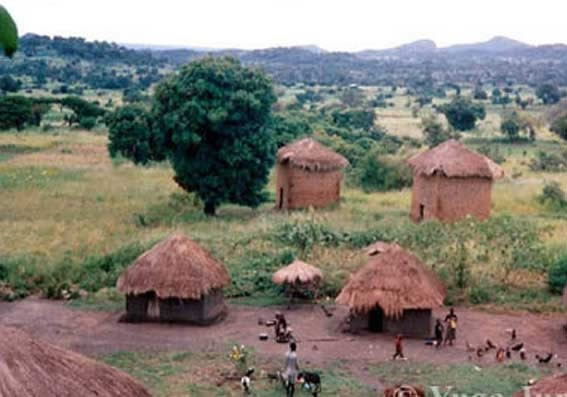
The Kumam belong to the Atekerin family together with the Langi, the Iteso and the Karimojong. This is the group of people which is often referred to ad the Nilo-Hamites. They live in western areas of Teso and southern of Lango. In Teso, they are found in the counties of Kaberamaido, Soroti and Serere and, in Lango, in the county of Kioga. Today, they can also be traced in to other areas of Uganda particularly in Busoga, Tororo and Buganda. Although they speak a Lwo dialect, their language is not Luo. It is Kumam. The Kumam language is over tow-thirds Lwo and one-third Ateso.
Origin
Historians claim that the Kumam came form the north- east in the direction of Ethiopia form around A.D. 1600. It is further asserted they derived form people who were originally Ateso speakers and who later learnt Lwo.It is said that due to contact with the Lwo speaking peoples from around Mt Otukei and wila in Karamoja, the Ateso (Dum) speech was abandoned and the Lwo speech was adopted.
They claim that their former name was leno. This can be evidenced by such phrases in their language as yo lango (path), pale lango (home), yat lango (medicine) and several others. They have common characteristics with the Iteso and the Lango with respect to birth rituals, certain social customs and hunting practices.
The Karimojong use the same word kumama when referring to the Iteso, the Langi and the Kumam. It is generally agreed that Kumam is derived form the Lango word Akum, meaning those people of the former Teso district who included the Iteso and some Langi. The Kumam are also referred to as the Ikokolemo. Ikoku is an Iteso word meaning “child” while elem is a Luo word meaning headdress. This means that the Kumam are a mixture of thee Luo and Atekerin possibly as a result of intermarriages between the Luo and the Ateker speaking peoples. As the Luo settled in northern Uganda, they came into contact with the Atekerin peoples who were also at the same time moving from the northeast and founding settlements in the northeastern Uganda. The fact that their language is half Lwo and half Ateker, lends some truth to this presupposition. Another legend talks of a boy who stole elem and fled somewhere with it and his descendants became the Kumam.
Political set-up
The Kumam had a loose political structure under clan leaders known as wegi Atekerin. Other people of importance in the society were wegi ikodeta Cel (leaders of dancing groups), and leaders of Asonya homes, wegi Cel. The wegi Cel were in most cases Dogolan or Odonge ikekoros (heads of part of a clan descending form one man). These clan leaders were responsible for the maintenance of law and order as well as general administration. They arbitrated in matters of politics and social affairs.
Social set-up
Their social system had elements of both the Langi and Iteso cultures. However, they were nearer to the Iteso than to the Langi. This was because the Langi were so much subjected to Luo influence that they lost most of their original influence.
Marriage
Previously, the parents would arrange marriages for their children. Girls of tender age would be betrothed to boys. In effect, the young girl would become wife to a respective boy but she would wait to be officially handed over when she came of age. In some cases, the young girls so betrothed would be taken to the boy’s home to grow up there. When she came of age, a ceremony would be organized to formalize the relationship. With time however the system changed. A boy would look for a girl and without the consent of the parents sneak with her to his home at night.
After a week or so, the girl’s relatives would begin to look for her. Obviously they had some prior knowledge of her whereabouts. On discovery, affine would be exacted form the boy. Arrangements would be made to settle the bridewealth and the marriage would be formalized.
If the girl’s parents did not race her where about, it was normal for her to go home and tell them what had happened other. Then due arrangements would be made to obtain the fine and bridewealth from her husband. The normal procedure was that the girl’s relatives would go to the boy’s home where the bridewealth would be negotiated. The cows could be taken that same day. Formerly, the number of cows which was paid was very large. It ranged between twelve to fifteen heads of cattle. The exact number depended on how hard working the girl was.
Birth
Whenever a woman was pregnant she was not supposed to eat the intestines of any animal. After giving birth a feast was organized. If the new born was a boy, it was given a spear and a girl was given a calabash. The ritual of giving a spear and a calabash was designed so they say to protect the child against bad omens. The name given to a child would reflect the experiences surrounding its birth or the experiences of the parents who named it. For instance if one’s children had been dying young, a new –born child was named Alobo if it was a girl or Lobolo if it was a boy. The umbilical cord and the placenta were buried in the house under a big pot previously used for keeping water. The purpose of this was to put them out of reach of wizards and other ill-wishers who might use them to affect the health of the child or to undermine the fertility of the mother.
Twins were considered good. Special rituals were performed after their birth. When twins were born, special green vegetables were prepared and the in-laws from the mother’s side were invited. A feast would be organized in which there would be a lot of eating and dancing. The ritual ceremony was intended to initiate the twins into the society.
Death
The Kumam did not believe in such a thing as natural death. Every death was attributed to witch craft. When one died, there was a lot of weeping and wailing. Burial would wait until all the relatives of the deceased had gathered. Mourning could go on for a week for both men and women. Although they did not appear to have believed in eternal life, they believed that the spirit of the dead did not die. They had power to inflict harm on the living. For this reason the family had a shrine for ancestral spirits. Here they were fed and rested during their wanderings and visits to the family. In the event of sickness or before going for a hunt or long journey, one would pass by his ancestors’ shrine to ask for health and good fortune.
Economy
The traditions of the Kumam indicate that they were traditionally pastoralists. They reared cattle, sheep, goats and chickens. Today they are partly pastoral and partly agricultural. Their staple food crops are kal (millet), bel (sorghum), kat (potatoes) with peas and beans as a common sauce. Land was communally owned by a clan. Any member of the clan was fully entitled t use it. Women and children did not own land. The women owned utensils which included agulu (big pots), tabo (small pots), itany (plates made from clay) as well as a variety of baskets and mats.
The Kumam were prone to the influence of the Luo. The Kumam language has a high percentage of Lwo words

 Posted in
Posted in 

